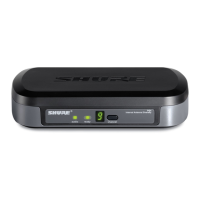24
25A1104 (Rev.1)
under test can cause erratic and poor measurements. Verify using a spectrum analyzer that the frequency of operation under
test has no interference down to -90dBm.
·Remove both CH. A & B internal antennas from CON500 & CON505.
·Set the receiver into ATE mode and to “2” (Fmid). This sets the receiver to the center operating frequency and set the am-
plitude to -50dBm. Conductively inject the output of the RF generator to the respective antenna input under test. For CH. A
inject into TP4 and for CH. B inject into TP5. No modulation is required unless specified.
.
Use a high impedance probe (FET Probe) & Spectrum Analyzer for all RF power measurements.
RF Troubleshooting
RF FRONT-END TO FIRST MIXER INPUT TROUBLESHOOTING:
1. The RF output at D510 should measure approximately -55dBm. If the RF amplitude is low check your signal path to the
input of D510. If the RF level is ok at the input of D510 verify that 3.3Vdc is present at pin 3. If so, replace D510.
2. The LNA input at pin 1 of IC520 should measure no less than approximately -55dBm. If so, check FL510 for proper tun-
ing & soldering and verify that C510, C511 and L511/C51 are the correct values.
3. Pin 11 of IC520 should measure approximately 15dB greater than the LNA input at pin 1. If the RF amplitude is low first
verify that pins 3 and 4 of IC520 measure about 3.5Vdc. If so, check C540, L540, L520, L545, C545, and L519 for poor
soldering and validate for correct part values. Lastly, if the RF amplitude is not approximately 15dB greater at pin 16 of
IC520 (LNA output) as compared to pin 1 (LNA input) replace IC520.
First mixer output (1
st
IF) & 1
st
LO troubleshooting:
Note for:
(Fo + 110.6MHz) ± 5.0 kHz for frequency groups H7,K7, M7, M10
(Fo - 110.6MHz) ± 5.0 kHz for frequency groups P11, Q11, R11, R12, R10, JB, T10
1. First check pin 6 of IC520 (1st IF output) it should measure 110.6MHz at approximately -35dBm. If the 1st IF output
amplitude is low verify that the 1st LO amplitude is no less than -5dBm at pin 8 of IC520.
2. If the 1st LO amplitude is low check the values and correct placement of all components leading back through the circuit
path to the collector of Q712. The 1st LO amplitude at the collector of Q712 should be no less than
0dBm(typ=+4.5dBm).
3. Verify that the 1st LO frequency is correct. If not, verify the correct channel setting. If channel setting is correct, measure
for 16 MHz +/- 160 Hz on pin 7 of IC1. If this frequency is deviated this can result in an offset in the 1st LO frequency. If
so, replace Y707.
4. If the 1st LO frequency is not present at pin 8 of IC520 verify that the tuning voltage of approximately 3.75Vdc is mea-
sured at TP1. If TP1 measures 0Vdc or near 5Vdc the VCO is not operating properly. Verify that pins 1 & 16 of IC1 mea-
sure approximately 4.5Vdc. If not, troubleshoot back through pins 2&4 of IC401 and verify that the electrolytic capacitor
C405 is not reversed. If none of the above is a problem possibly either IC1 is defective or IC300 is not properly pro-
grammed or defective.
2
nd
mixer input & 2
nd
LO output troubleshooting:
Note for:
Board groups H7, K7, M7, M10 the 2nd LO is low side injected (1st IF -99.9MHz).
Board groups P11, Q11, R11, R12, R10, JB, T10 the 2nd LO is high side injected (121.3MHz - 1stIF).
(Three sections to look at: 1st IF, 2nd LO and 2nd IF)
1. Verify that the 5Vdc supply is at pin 5 of IC610. If not, verify for correct placement and component values associated
with the 5Vdc supply to IC610.
2. Verify pin 12 of IC610 (2nd IF input into detector) measures 10.7MHz at approximately -15dBm. If the 10.7MHz
amplitude is low or is not present check back through FL635 & FL620 to pin 14 of IC610 (2nd IF output from detector).
If the 10.7MHz signal at pin 14 of IC610 is very weak or not present proceed with 1stIF & 2ndLO troubleshooting sec-
tions. If the 1st IF and 2nd LO signals test fine at IC610 but the 10.7MHz signal at pin 14 of IC610 is very weak or not
present replace IC610.
3. Verify pin 16 of IC610 (1stIF input into detector) measures 110.6MHz at approximately -10dBm. If not, verify the volt-
age on the collector of Q603 measures approximately 5Vdc. If not, troubleshoot back through the 5Vdc-supply circuit. If
the voltage was correct on the collector of Q603 verify the base measures approximately 3.2Vdc and the emitter mea-
sures approximately 1.08Vdc. If not check for correct component placement and values around Q603. If the base and

